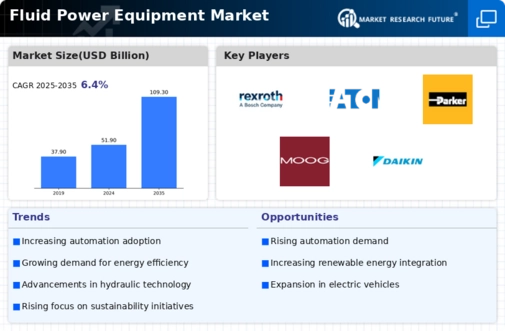Growing Focus on Renewable Energy
The Fluid Power Equipment Market is increasingly influenced by the growing focus on renewable energy sources. As nations strive to reduce their carbon footprints and transition towards sustainable energy solutions, the demand for fluid power systems in renewable energy applications is expected to rise. In 2025, investments in renewable energy infrastructure are projected to exceed 1 trillion dollars, creating opportunities for fluid power equipment manufacturers. Hydraulic systems are essential in wind turbines and solar energy installations, providing the necessary force for operation and maintenance. This trend suggests that fluid power equipment will play a pivotal role in supporting the renewable energy sector, thereby driving market growth. Additionally, as technology evolves, fluid power solutions are likely to become more efficient and environmentally friendly, further enhancing their appeal in the renewable energy landscape.
Rising Demand in Construction Sector
The Fluid Power Equipment Market experiences a notable surge in demand driven by the construction sector. As urbanization accelerates, the need for heavy machinery and equipment that utilize fluid power systems becomes increasingly critical. In 2025, the construction industry is projected to grow at a compound annual growth rate of approximately 5.5%, which directly influences the fluid power equipment market. Hydraulic systems, in particular, are essential for cranes, excavators, and other construction machinery, enhancing efficiency and productivity. This trend indicates a robust market potential for fluid power equipment manufacturers, as they align their offerings with the evolving needs of the construction sector. Furthermore, the integration of advanced technologies in construction equipment is likely to further bolster the demand for fluid power solutions, making this sector a key driver for the industry.
Increased Automation in Manufacturing
The Fluid Power Equipment Market is significantly impacted by the ongoing trend of increased automation in manufacturing processes. As industries strive for higher efficiency and reduced operational costs, the adoption of automated systems that utilize fluid power technology is on the rise. In 2025, it is estimated that the automation market will reach a valuation of over 200 billion dollars, with fluid power systems playing a crucial role in this transformation. Pneumatic and hydraulic systems are integral to automated machinery, providing the necessary force and precision for various applications. This shift towards automation not only enhances productivity but also reduces labor costs, thereby driving the demand for fluid power equipment. Consequently, manufacturers are likely to invest in innovative fluid power solutions to meet the growing needs of automated manufacturing environments.
Advancements in Fluid Power Technology
The Fluid Power Equipment Market is witnessing substantial growth due to advancements in fluid power technology. Innovations such as smart hydraulic systems and energy-efficient pneumatic solutions are reshaping the landscape of fluid power applications. In 2025, the market for energy-efficient fluid power systems is expected to expand significantly, driven by the increasing emphasis on sustainability and operational efficiency. These technological advancements enable better control, reduced energy consumption, and enhanced performance of fluid power equipment. As industries seek to optimize their operations, the demand for cutting-edge fluid power solutions is likely to rise. Furthermore, the integration of IoT and data analytics into fluid power systems may provide manufacturers with valuable insights, allowing for predictive maintenance and improved system reliability, thus propelling the growth of the fluid power equipment market.
Expansion of Agricultural Mechanization
The Fluid Power Equipment Market is experiencing growth due to the expansion of agricultural mechanization. As the global population continues to rise, the demand for efficient agricultural practices is becoming increasingly critical. In 2025, the agricultural machinery market is anticipated to grow at a rate of approximately 6%, with fluid power systems being integral to modern farming equipment. Hydraulic systems are widely used in tractors, harvesters, and irrigation systems, enhancing productivity and reducing labor requirements. This trend indicates a strong potential for fluid power equipment manufacturers to cater to the evolving needs of the agricultural sector. Furthermore, the integration of advanced technologies such as precision farming and automated machinery is likely to further drive the demand for fluid power solutions, positioning the industry for sustained growth.


















Leave a Comment